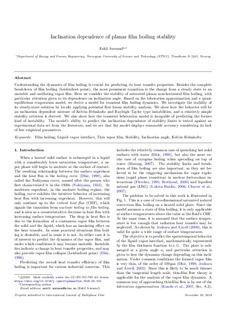| dc.contributor.author | Aursand, Eskil | |
| dc.date.accessioned | 2019-02-14T12:29:13Z | |
| dc.date.available | 2019-02-14T12:29:13Z | |
| dc.date.created | 2018-05-29T15:55:43Z | |
| dc.date.issued | 2018 | |
| dc.identifier.citation | International Journal of Multiphase Flow. 2018, 106 243-253. | nb_NO |
| dc.identifier.issn | 0301-9322 | |
| dc.identifier.uri | http://hdl.handle.net/11250/2585460 | |
| dc.description.abstract | Understanding the dynamics of film boiling is crucial for predicting its heat transfer properties. Besides the complete breakdown of film boiling (Leidenfrost point), the most prominent transition is the change from a steady state to an unstable and oscillating vapor film. Here we consider the stability of saturated planar non-horizontal film boiling, with particular attention given to its dependence on inclination angle. Based on the lubrication approximation and a quasi-equilibrium evaporation model, we derive a model for transient film boiling dynamics. We investigate the stability of its steady-state solution by locally applying potential flow linear stability analysis. We show how the behavior will be an inclination dependent mixture of Kelvin–Helmholtz and Rayleigh–Taylor type instabilities, and a relatively simple stability criterion is derived. We also show how the transient lubrication model is incapable of predicting the former kind of instability. The model’s ability to predict the inclination dependence of stability limits is tested against an experimental data set from the literature, and we see that the model displays reasonable accuracy considering its lack of free empirical parameters. | nb_NO |
| dc.language.iso | eng | nb_NO |
| dc.publisher | Elsevier | nb_NO |
| dc.rights | Attribution-NonCommercial-NoDerivatives 4.0 Internasjonal | * |
| dc.rights.uri | http://creativecommons.org/licenses/by-nc-nd/4.0/deed.no | * |
| dc.title | Inclination dependence of planar film boiling stability | nb_NO |
| dc.title.alternative | Inclination dependence of planar film boiling stability | nb_NO |
| dc.type | Journal article | nb_NO |
| dc.type | Peer reviewed | nb_NO |
| dc.description.version | acceptedVersion | nb_NO |
| dc.source.pagenumber | 243-253 | nb_NO |
| dc.source.volume | 106 | nb_NO |
| dc.source.journal | International Journal of Multiphase Flow | nb_NO |
| dc.identifier.doi | 10.1016/j.ijmultiphaseflow.2018.05.010 | |
| dc.identifier.cristin | 1587506 | |
| dc.relation.project | Norges forskningsråd: 244076 | nb_NO |
| dc.description.localcode | © 2018. This is the authors’ accepted and refereed manuscript to the article. Locked until 11.5.2020 due to copyright restrictions. This manuscript version is made available under the CC-BY-NC-ND 4.0 license http://creativecommons.org/licenses/by-nc-nd/4.0/ | nb_NO |
| cristin.unitcode | 194,64,25,0 | |
| cristin.unitname | Institutt for energi- og prosessteknikk | |
| cristin.ispublished | true | |
| cristin.fulltext | postprint | |
| cristin.qualitycode | 1 | |

